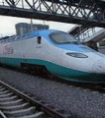请认真阅读下面短文,并根据短文内容回答问题。 A 9.0-magnitude earthquake occurredoff the northeastern coast of Japan on 11 MarchThe earthquake in Japan on March -九年级英语
题文
| 请认真阅读下面短文,并根据短文内容回答问题。 A 9.0-magnitude earthquake occurred off the northeastern coast of Japan on 11 March  The earthquake in Japan on March 11,2011 was a 9.0 on the Richter scale (里氏). Over 6,500 died because of the disaster by March 18. The earthquake also caused a tsunami (海啸) and a nuclear leak (核泄漏). However, most Japanese people stayed calm and orderly.They left broken houses calmly. They waited in line for food, water and public telephones. There was no robbing (抢劫) and no pushing. Earthquakes hit Japan almost every year. People are ready for an earthquake at any time.  In Japan, you can learn about earthquakes on TV and in schoolbooks. Even the famous comic, Sakura Momoko (《樱桃小丸子》), shows earthquake training in a school. Almost every family in Japan has a survival kit (救生包). The kit has a flashlight (手电筒), a radio, water and enough food for several days. Most buildings in Japan use wood. The material is less dangerous during a disaster. The buildings can stand an earthquake of up to 7.0 on the Richter scale. 小题1:How large was the earthquake in Japan on March 11? 小题2:What did the earthquake cause besides many people’s death? 小题3:Where can Japanese people learn about earthquakes? 小题4:What are most buildings in Japan made of? 小题5:What can we learn from Japanese people if the disaster happens to us? |
答案
小题1:A 9.0 on the Richter scale. 小题2:A tsunami and a nuclear leak . 小题3:On TV and in schoolbooks. 小题4:Wood. 小题5:We should stay calm and orderly. /We should leave broken houses calmly. /We should wait in line for food, water and public telephones. |
1.根据The earthquake in Japan on March 11,2011 was a 9.0 on the Richter scale (里氏)可知日本发生了里氏9级地震。 2.根据The earthquake also caused a tsunami (海啸) and a nuclear leak (核泄漏)可知地震也导致了海啸和核泄漏。 3.根据In Japan, you can learn about earthquakes on TV and in schoolbooks可知了解地震可以通过电视和学校的书籍。 4.根据Most buildings in Japan use wood可知大部分建筑物是使用的木材。 5.这个题答案多样,根据However, most Japanese people stayed calm and orderly可知地震时要保持镇定和有序;根据They left broken houses calmly可知我们要镇定地离开破损的房子等。 |
据专家权威分析,试题“请认真阅读下面短文,并根据短文内容回答问题。 A 9.0-magnitud..”主要考查你对 新闻报道类阅读 等考点的理解。关于这些考点的“档案”如下:
新闻报道类阅读
考点名称:新闻报道类阅读
- 报刊阅读应逐步成为中学生阅读的一个重要内容。由于新闻报道强调遵循5个W和1个H的原则,学生在阅读时也要抓住这一点去理解。
- 新闻报道类阅读的注意事项:
1. 品味新闻的标题,联系平时所积累的知识,为了解材料大意作铺垫。
2. 了解新闻报道的特殊规律,其内容和多含何人、何地、何事、何时等,阅读时要抓住新闻的这一主要特点去理解判断。
3. 要注意文中以黑体、大写、下划线等方式加以提示的文字,因为这很有可能是材料的核心或至少是一部分内容的概括。
新闻报道类阅读答题技巧:
1.审视标题,抓住中心<?xml:namespace prefix = "o" ns = "urn:schemas-microsoft-com:office:office" />
试题中有的文章有标题,有的没有,拟题人是有所考虑的。标题是文章主题的高度凝聚。
它能给我们启发和想象,想象文章的内容和走向。这样做有利于对文章的理解,能提高做题的效率。2.浏览全文,掌握全貌
如果时间紧,至少要快速通读全文,尤其是首两段。再把标题和文章内容结合起来,这样全文的梗概便一目了然了。
3.细读题目,抓住要点
对整篇短文内容有了一定的了解后,要马上看短文后的问题,带着问题去选择或判断答案。要确定所需查找的信息范围,并注意所查找信息的特点。例如:
如果问题或选项涉及到人名、地名,就应该找首字母大写的单词;如果问题或选项涉及时间、日期、数字,就应该寻找具体的数据。
另外还要注意试题难易,应暂时绕开那些少数较难的题目,先做最有把握、最熟悉的题目,也就是该类题可以直接或间接从文章中找到的。
- 最新内容
- 相关内容
- 网友推荐
- 图文推荐
| [家长教育] 孩子为什么会和父母感情疏离? (2019-07-14) |
| [教师分享] 给远方姐姐的一封信 (2018-11-07) |
| [教师分享] 伸缩门 (2018-11-07) |
| [教师分享] 回家乡 (2018-11-07) |
| [教师分享] 是风味也是人间 (2018-11-07) |
| [教师分享] 一句格言的启示 (2018-11-07) |
| [教师分享] 无规矩不成方圆 (2018-11-07) |
| [教师分享] 第十届全国教育名家论坛有感(二) (2018-11-07) |
| [教师分享] 贪玩的小狗 (2018-11-07) |
| [教师分享] 未命名文章 (2018-11-07) |






